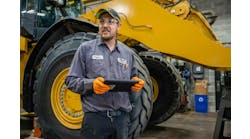Mom-and-pop shops desperate for technicians, parts: Fullbay reports
ORLANDO, Florida—“Most of the trucks on the road are fixed, maintained, serviced, and repaired by independent, typically ‘mom-and-pop’ shops,” prefaced Fullbay Executive Chair and Founder Jacob Findlay before diving into the insights gleaned from the company’s second annual State of Heavy-Duty Repair Industry Report at American Trucking Associations’ Technology & Maintenance Council 2022 Annual Meeting & Transportation Technology Exhibition.
TMC and MOTOR partnered with the Phoenix-based heavy-duty repair shop software provider on the study, which provides a comprehensive look at what’s going on with these independent shops, which number in the tens of thousands.
Fullbay itself has a customer base in the thousands, and leveraged 500 of their customers’ anonymized repair data for quantitative analysis (the customer must have used the platform for 12 continuous months), while 900 respondents from throughout the industry (commercial freight, logistics, and repair industries) contributed to the qualitative portion via a survey.
“Because we're cloud-based, we have by far the largest collection of real time repair information in our North America. And because of that massive amount of data, we have a unique ability to see what's going on in the industry in an anonymized way to do this kind of analysis,” Findlay explained.
The 65-page report is free, and you can download it here: Fullbay 2022 State of Heavy-Duty Repair Industry Report.
Among the primary insights from that were reported:
- 82% reported at least some disruption due to parts shortages, with 17% listing extreme disruptions
- 4% of shops boasted of no parts disruption
- 51% said hiring technicians was their top challenge, while 65% overall found hiring difficult
- 46% also flagged lack of skills as a technician trouble area
- 22% of shops that don't charge for DOT (Department of Transportation) inspections
- 22% don’t charge for diagnostics
- 23% don't use a labor guide
- 31% do not know how efficient their technicians are
- 73% provided a wage increase (meaning 27% did not)
The technician and parts responses should not come as a shock to anyone within even a cursory knowledge of the industry
Findlay summarized it like this: “We know that the quantity of technicians and shops were able to maintain equipment is going down at the same time that the quantity of equipment on the road is going up, so you have this tension happening.”
Economics approach
But how to ease the tension?
Any technician will tell you the trick is to pay them more money. That is what 73% of shops in the report did, with an average hourly wage increase was $13.80.
Findlay, a former accountant once on a track for a Ph.D. in accounting and career as a professor, really harped on not what numbers were there, but what weren't.
“You would think it would be 100%, given the period of price inflation that we're going through,” Findlay postulated. “So over a quarter of the shops surveyed [reported] zero increase in technician wage last year. And I’m fairly confident that those shops are increasing turnover and decreasing their proficiency recruitment capabilities.”
The bottom line is that saving money is really diminishing a shop’s value to fleets. You won’t keep the best, most skilled technicians, so a trucking company or owner-operator is almost assured to get higher quality work elsewhere, Findlay explained.
“You do need to pay the technicians what they are worth in the market as a shop, and the fleets need to be willing to pay a higher labor rate to keep that shop in business,” he said. “The fleets will be okay paying those higher rates, because their trucks will be operational more consistently, and they will make more money with the trucks. We all cooperate together and it's a true win-win.”
This also increases the diesel technician trade’s value in the job market.
“Paying higher and higher labor rates as the quantity goes down will create new entrants into the diesel technician market—it’s classic supply and demand,” Findlay said.
He did offer a possible reason for why one in four shops surveyed did not increase labor costs, which according to the latest TMC/Decisiv benchmarking report went up 14.2% across the industry.
“They're doing great work, but they feel bad charging their customers more,” Findlay offered. “And maybe they gave some incremental increases to their technicians, but they're not thinking necessarily in terms of fair change value.”
Fullbay recommends that for every $0.50 increase in technician wages, shops should increase labor rates by $1.
It’s also important to know how effective those technicians are, though 31% of shops said they did not track that.
“That means they're paying technicians 40 hours a week, but they don't know how much time their technicians are actually spending working on the trucks,” Findlay said.
Strategy to increase revenue
Another way for shops to increase revenue is by charging fairly for the service rendered. As previously mentioned, the report found 22% of shops did not charge for DOT inspections, and 22% did not charge for diagnostics.
In the report, Don Doty, VP at FleetNet America, said: “Performing DOTs should not be a courtesy item. It's important service providers get paid fairly for their [work] if they are going to invest in the people, tools, equipment, and technology to be at the top of their game. I can't stress how important it is, and will be, that shops [charge properly] to fuel their business.”
Findlay added that it could be a great opportunity for an upsell that the fleet will thank you for.
“You're probably going to find other things that the shop can work on and can make money on,” he said. “But it also helps the fleet prevent unscheduled downtime, which is an order of magnitude more important than anything else in the fleet.”








